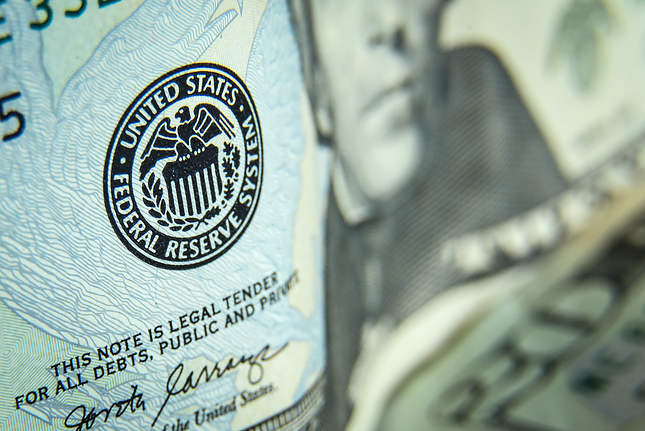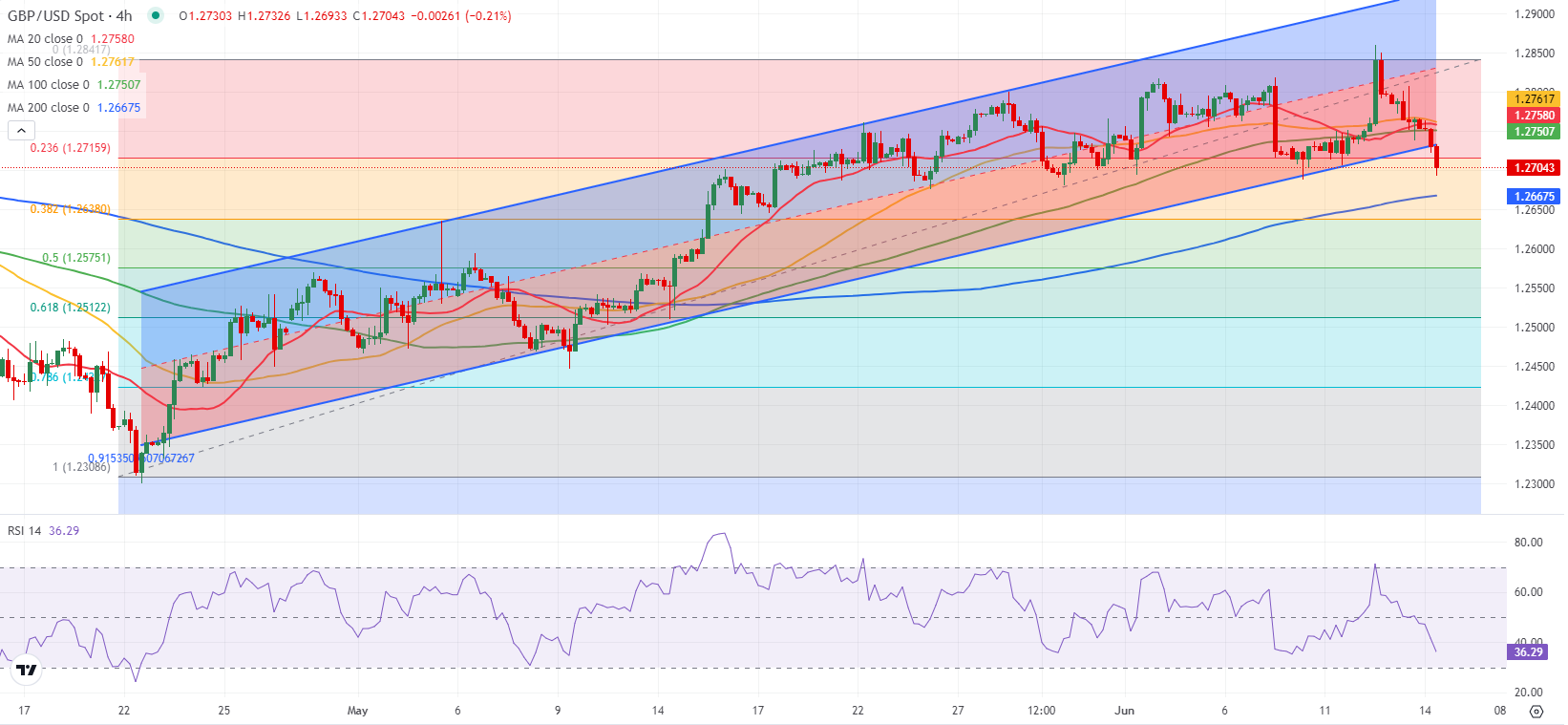- GBP/USD stays on the back foot and tests 1.2700 on Friday.
- The near-term technical outlook points to a bearish tilt.
- The USD could continue to benefit from the souring market mood.
GBP/USD closed in negative territory on Thursday and snapped a three-day winning streak. The pair struggles to hold its ground early Friday and tests 1.2700.
British Pound PRICE This week
The table below shows the percentage change of British Pound (GBP) against listed major currencies this week. British Pound was the weakest against the Swiss Franc.
| USD | EUR | GBP | JPY | CAD | AUD | NZD | CHF | |
|---|---|---|---|---|---|---|---|---|
| USD | 1.09% | 0.13% | 0.17% | -0.00% | -0.43% | -0.36% | -0.42% | |
| EUR | -1.09% | -0.61% | -0.67% | -0.83% | -1.23% | -1.18% | -1.24% | |
| GBP | -0.13% | 0.61% | 0.08% | -0.21% | -0.62% | -0.58% | -0.64% | |
| JPY | -0.17% | 0.67% | -0.08% | -0.16% | -0.67% | -0.64% | -0.54% | |
| CAD | 0.00% | 0.83% | 0.21% | 0.16% | -0.39% | -0.36% | -0.42% | |
| AUD | 0.43% | 1.23% | 0.62% | 0.67% | 0.39% | 0.05% | -0.02% | |
| NZD | 0.36% | 1.18% | 0.58% | 0.64% | 0.36% | -0.05% | -0.06% | |
| CHF | 0.42% | 1.24% | 0.64% | 0.54% | 0.42% | 0.02% | 0.06% |
The heat map shows percentage changes of major currencies against each other. The base currency is picked from the left column, while the quote currency is picked from the top row. For example, if you pick the British Pound from the left column and move along the horizontal line to the US Dollar, the percentage change displayed in the box will represent GBP (base)/USD (quote).
The US Dollar erased a portion of Wednesday losses in the European session on Thursday. Although the soft producer inflation data limited the USD's rebound in the early American session, the souring risk mood helped the currency regather its strength later in the day.
Early Friday, safe-haven flows continue to dominate the financial markets, helping the USD continue to outperform its rivals. Additionally, the USD seems to be capturing capital outflows out of the Euro, which struggles to find demand amid political jitters, and the Japanese Yen, which stays under selling pressure following the Bank of Japan's decision to hold policy settings unchanged.
The University of Michigan's (UoM) Consumer Sentiment Survey will be featured in the US economic calendar on Friday. Investors, however, could continue to react to changes in risk perception heading into the weekend.
As of writing, US stock index futures were down between 0.65% and 0.1%. A bearish opening in Wall Street, followed by an extended slide, could further boost the USD and weigh on GBP/USD.
GBP/USD Technical Analysis
GBP/USD dropped below the lower limit of the ascending regression channel and the Relative Strength Index (RSI) indicator on the 4-hour chart fell below 40, reflecting the bearish tilt in the short term outlook.
On the downside, the 200-period Simple Moving Average (SMA) aligns as first support at 1.2670 before 1.2640 (Fibonacci 38.2% retracement) and 1.2600 (psychological level, static level).
If GBP/USD returns within the ascending channel by rising above 1.2730, sellers could be discouraged. In this case, 1.2750 (100-period SMA) could act as interim resistance before 1.2800 (psychological level, static level).
Pound Sterling FAQs
The Pound Sterling (GBP) is the oldest currency in the world (886 AD) and the official currency of the United Kingdom. It is the fourth most traded unit for foreign exchange (FX) in the world, accounting for 12% of all transactions, averaging $630 billion a day, according to 2022 data. Its key trading pairs are GBP/USD, aka ‘Cable’, which accounts for 11% of FX, GBP/JPY, or the ‘Dragon’ as it is known by traders (3%), and EUR/GBP (2%). The Pound Sterling is issued by the Bank of England (BoE).
The single most important factor influencing the value of the Pound Sterling is monetary policy decided by the Bank of England. The BoE bases its decisions on whether it has achieved its primary goal of “price stability” – a steady inflation rate of around 2%. Its primary tool for achieving this is the adjustment of interest rates. When inflation is too high, the BoE will try to rein it in by raising interest rates, making it more expensive for people and businesses to access credit. This is generally positive for GBP, as higher interest rates make the UK a more attractive place for global investors to park their money. When inflation falls too low it is a sign economic growth is slowing. In this scenario, the BoE will consider lowering interest rates to cheapen credit so businesses will borrow more to invest in growth-generating projects.
Data releases gauge the health of the economy and can impact the value of the Pound Sterling. Indicators such as GDP, Manufacturing and Services PMIs, and employment can all influence the direction of the GBP. A strong economy is good for Sterling. Not only does it attract more foreign investment but it may encourage the BoE to put up interest rates, which will directly strengthen GBP. Otherwise, if economic data is weak, the Pound Sterling is likely to fall.
Another significant data release for the Pound Sterling is the Trade Balance. This indicator measures the difference between what a country earns from its exports and what it spends on imports over a given period. If a country produces highly sought-after exports, its currency will benefit purely from the extra demand created from foreign buyers seeking to purchase these goods. Therefore, a positive net Trade Balance strengthens a currency and vice versa for a negative balance.
Information on these pages contains forward-looking statements that involve risks and uncertainties. Markets and instruments profiled on this page are for informational purposes only and should not in any way come across as a recommendation to buy or sell in these assets. You should do your own thorough research before making any investment decisions. FXStreet does not in any way guarantee that this information is free from mistakes, errors, or material misstatements. It also does not guarantee that this information is of a timely nature. Investing in Open Markets involves a great deal of risk, including the loss of all or a portion of your investment, as well as emotional distress. All risks, losses and costs associated with investing, including total loss of principal, are your responsibility. The views and opinions expressed in this article are those of the authors and do not necessarily reflect the official policy or position of FXStreet nor its advertisers. The author will not be held responsible for information that is found at the end of links posted on this page.
If not otherwise explicitly mentioned in the body of the article, at the time of writing, the author has no position in any stock mentioned in this article and no business relationship with any company mentioned. The author has not received compensation for writing this article, other than from FXStreet.
FXStreet and the author do not provide personalized recommendations. The author makes no representations as to the accuracy, completeness, or suitability of this information. FXStreet and the author will not be liable for any errors, omissions or any losses, injuries or damages arising from this information and its display or use. Errors and omissions excepted.
The author and FXStreet are not registered investment advisors and nothing in this article is intended to be investment advice.
Recommended Content
Editors’ Picks

AUD/USD appreciates as US Dollar remains subdued after a softer inflation report
The Australian Dollar steadies following two days of gains on Monday as the US Dollar remains subdued following the Personal Consumption Expenditures Price Index data from the United States released on Friday.

USD/JPY consolidates around 156.50 area; bullish bias remains
USD/JPY holds steady around the mid-156.00s at the start of a new week and for now, seems to have stalled a modest pullback from the 158.00 neighborhood, or over a five-month top touched on Friday. Doubts over when the BoJ could hike rates again and a positive risk tone undermine the safe-haven JPY.

Gold downside bias remains intact while below $2,645
Gold price is looking to extend its recovery from monthly lows into a third day on Monday as buyers hold their grip above the $2,600 mark. However, the further upside appears elusive amid a broad US Dollar bounce and a pause in the decline of US Treasury bond yields.

Week ahead: No festive cheer for the markets after hawkish Fed
US and Japanese data in focus as markets wind down for Christmas. Gold and stocks bruised by Fed, but can the US dollar extend its gains? Risk of volatility amid thin trading and Treasury auctions.

Bank of England stays on hold, but a dovish front is building
Bank of England rates were maintained at 4.75% today, in line with expectations. However, the 6-3 vote split sent a moderately dovish signal to markets, prompting some dovish repricing and a weaker pound. We remain more dovish than market pricing for 2025.

Best Forex Brokers with Low Spreads
VERIFIED Low spreads are crucial for reducing trading costs. Explore top Forex brokers offering competitive spreads and high leverage. Compare options for EUR/USD, GBP/USD, USD/JPY, and Gold.
